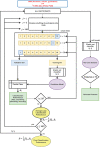Multimodal magnetic resonance neuroimaging measures characteristic of early cART-treated pediatric HIV: A feature selection approach
- PMID: 35575438
- PMCID: PMC9374890
- DOI: 10.1002/hbm.25907
Multimodal magnetic resonance neuroimaging measures characteristic of early cART-treated pediatric HIV: A feature selection approach
Abstract
Children with perinatally acquired HIV (CPHIV) have poor cognitive outcomes despite early combination antiretroviral therapy (cART). While CPHIV-related brain alterations can be investigated separately using proton magnetic resonance spectroscopy (1 H-MRS), structural magnetic resonance imaging (sMRI), diffusion tensor imaging (DTI), and functional MRI (fMRI), a set of multimodal MRI measures characteristic of children on cART has not been previously identified. We used the embedded feature selection of a logistic elastic-net (EN) regularization to select neuroimaging measures that distinguish CPHIV from controls and measured their classification performance via the area under the receiver operating characteristic curve (AUC) using repeated cross validation. We also wished to establish whether combining MRI modalities improved the models. In single modality analysis, sMRI volumes performed best followed by DTI, whereas individual EN models on spectroscopic, gyrification, and cortical thickness measures showed no class discrimination capability. Adding DTI and 1 H-MRS in basal measures to sMRI volumes produced the highest classification performance . The best multimodal MRI set consisted of 22 DTI and sMRI volume features, which included reduced volumes of the bilateral globus pallidus and amygdala, as well as increased mean diffusivity (MD) and radial diffusivity (RD) in the right corticospinal tract in cART-treated CPHIV. Consistent with previous studies of CPHIV, select subcortical volumes obtained from sMRI provide reasonable discrimination between CPHIV and controls. This may give insight into neuroimaging measures that are relevant in understanding the effects of HIV on the brain, thereby providing a starting point for evaluating their link with cognitive performance in CPHIV.
Keywords: DTI; HIV; MR spectroscopy; MRI; classification; elastic net; neuroimaging; pediatric; regularization; sMRI.
© 2022 The Authors. Human Brain Mapping published by Wiley Periodicals LLC.
Conflict of interest statement
The authors declare no conflicts of interest.
Figures




References
-
- Ackermann, C. , Andronikou, S. , Saleh, M. G. , Laughton, B. , Alhamud, A. A. , Kouwe, A. , Kidd, M. , Cotton, M. F. , & Meintjes, E. M. (2016). Early antiretroviral therapy in HIV‐infected children is associated with diffuse white matter structural abnormality and corpus callosum sparing. American Journal of Neuroradiology, 37, 2363–2369. 10.3174/ajnr.A4921 - DOI - PMC - PubMed
-
- Akaike, H. (1973). Maximum likelihood identification of gaussian autoregressive moving average models. Biometrika, 60, 255–265. 10.1093/biomet/60.2.255 - DOI
-
- Anderson, K. P. , & Burnham, D. A. (2002). Model selection and multi‐model inference: A practical information‐theoretic approach (2nd edition). Ecological Modelling, 172, 96–97. 10.1016/j.ecolmodel.2003.11.004 - DOI
Publication types
MeSH terms
Grants and funding
LinkOut - more resources
Full Text Sources
Medical
Research Materials
Miscellaneous

